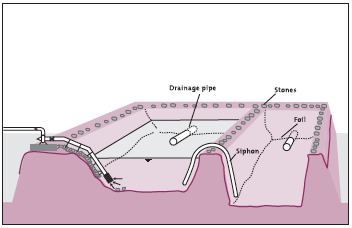Difference between revisions of "Storage / Pre-settlement"
| Line 9: | Line 9: | ||
Reservoirs for sedimentation usually have two separate sections. While one is in use, the other can be cleaned. They have an intake on one side of the reservoir (or at the bottom), an outlet on the opposite side just beneath the water level, and a bottom outlet to flush the deposited material. When the water quantity or quality at the source is temporarily low, a large storage reservoir can also provide an alternative temporary source of water. | Reservoirs for sedimentation usually have two separate sections. While one is in use, the other can be cleaned. They have an intake on one side of the reservoir (or at the bottom), an outlet on the opposite side just beneath the water level, and a bottom outlet to flush the deposited material. When the water quantity or quality at the source is temporarily low, a large storage reservoir can also provide an alternative temporary source of water. | ||
| + | |||
| + | ==Suitable conditions== | ||
| + | '''Range of depth:''' Usually, 0.7–2.0 m. | ||
| + | '''Treatment time:''' A few hours to several days. | ||
| + | '''Area of use:''' Wherever raw water contains high concentrations of suspended solids, or where the quality or quantity of the water at the source varies considerably. | ||
| + | |||
| + | ==Construction, operations and maintenance== | ||
| + | Usually, water will be let in to the storage reservoir every day or continuously, but when the water quality becomes too poor and there is sufficient water stored in the reservoir, the water intake may be stopped temporarily. The reservoir will have to be flushed regularly to remove the deposited silt – the frequency for this will depend on the silt content of the water and the reservoir depth. All valves in the system must be opened and closed at least once every two months to keep them from becoming stuck. Occasionally, the valves may need to be repaired or replaced, and leaks in the reservoir will have to be | ||
| + | fixed. Apart from some help from the water users to clean the reservoir after it has been flushed, the system requires little support from an established organization to maintain it. | ||
Revision as of 21:07, 13 July 2012
The quality of raw water can be improved considerably by storage. During storage, non-colloidal, suspended particles slowly settle to the bottom of a storage tank, and solar radiation will kill some of the harmful organisms in the water. Schistosoma larvae, for example, will die after storage for at least 48 hours. In contrast, colloidal particles remain in suspension. The smaller the suspended particles, the longer the water needs to be retained in the reservoir. If the suspended matter precipitates very slowly, chemicals can be added to induce coagulation and flocculation.
The reservoir can be constructed in several ways:
— below ground level, with a lining of plastic sheeting to separate the stored water from the ground;
— with a lining of loam, clay or concrete;
— entirely from brick or concrete.
Reservoirs for sedimentation usually have two separate sections. While one is in use, the other can be cleaned. They have an intake on one side of the reservoir (or at the bottom), an outlet on the opposite side just beneath the water level, and a bottom outlet to flush the deposited material. When the water quantity or quality at the source is temporarily low, a large storage reservoir can also provide an alternative temporary source of water.
Suitable conditions
Range of depth: Usually, 0.7–2.0 m. Treatment time: A few hours to several days. Area of use: Wherever raw water contains high concentrations of suspended solids, or where the quality or quantity of the water at the source varies considerably.
Construction, operations and maintenance
Usually, water will be let in to the storage reservoir every day or continuously, but when the water quality becomes too poor and there is sufficient water stored in the reservoir, the water intake may be stopped temporarily. The reservoir will have to be flushed regularly to remove the deposited silt – the frequency for this will depend on the silt content of the water and the reservoir depth. All valves in the system must be opened and closed at least once every two months to keep them from becoming stuck. Occasionally, the valves may need to be repaired or replaced, and leaks in the reservoir will have to be fixed. Apart from some help from the water users to clean the reservoir after it has been flushed, the system requires little support from an established organization to maintain it.

